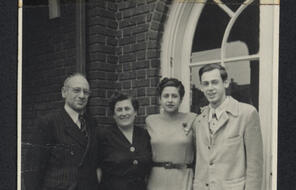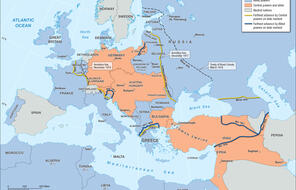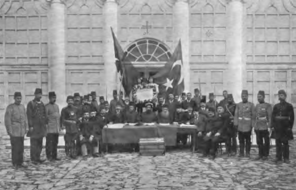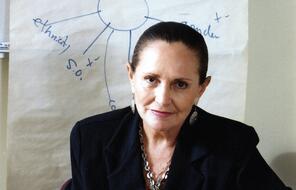Anti-Judaism before the Enlightenment
Subject
- Civics & Citizenship
- History
- Social Studies
Language
English — USAvailable in
Updated
The Ancient Roots of Anti-Judaism
In the late 1700s and early 1800s, American and French Jews felt vulnerable as their countries debated their loyalty (see reading, Religion, Loyalty, and Belonging). In the mid-1800s, Germans argued over whether or not Jews could belong in the German nation (see reading, Creating the German Nation). All of these debates were influenced by hundreds of years of prejudice, hatred, and violence toward Jews.
Persecution of Jews During the Plague
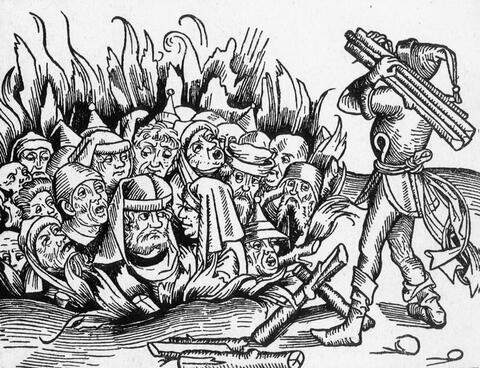
Persecution of Jews During the Plague
In much of Europe during the Middle Ages, Christians blamed Jews for the plague. In many towns, officials arrested Jews, confiscated their property, and burned them at the stake.
Judaism, a religious faith that has existed for more than 3,000 years, is the oldest monotheistic religion. Throughout much of the faith’s history, Jews lived in territories ruled by other groups. They were often treated as “the Other” and made scapegoats for calamities and misfortunes suffered by societies in which they lived. Continuous rumors, lies, myths, and misinformation about Jews have existed throughout history, and many of them persist in the contemporary world. Often this hatred has led to violence.
Historians have traced anti-Jewish myths, hatred, and violence back more than 2,000 years to the time of the Roman Empire. Tensions with the Romans led Jews in Palestine to revolt in 66 CE. The Romans responded violently. Historian Doris Bergen explains:
Roman authorities worried that Jewish refusal to worship local and imperial gods would jeopardize the security of the state. At times such unease, coupled with political conflicts, turned into open persecution and attacks. In 70 C.E. the Romans destroyed the Jewish temple in Jerusalem, the focal point of Jewish life up to that time; sixty years later they dispersed the Jews of Palestine, scattering them far from the region that had been their home.
During this same period, a new faith was born out of Judaism and began to spread across the Roman Empire. Bergen continues:
The rise of Christianity added new fuel to anti-Jewish sentiments. Christianity grew out of Judaism—Jesus himself was a Jew, as were the apostles and important figures such as Paul of Tarsus. Nevertheless, early Christians tried to separate themselves from other Jews, both to win followers from the gentile (non-Jewish) world and to gain favor with Roman imperial authorities. Some early Christians also stressed their loyalty to the state by pointing out that the Kingdom of God was not of this earth and therefore did not compete with Rome. Such efforts paid off; in less than four hundred years, Christianity went from being a persecuted branch of Judaism to being the dominant religion of the Roman Empire. It is significant that some early Christian accounts blamed Jews for Jesus’ death even though crucifixion was a specifically Roman form of punishment commonly practiced during Jesus’ time. The version of events that had Jewish mobs demanding Jesus’ death while the Roman governor Pontius Pilate washed his hands allowed later Christians to emphasize their difference from Judaism and downplay the hostility that Roman authorities had shown toward Christianity in its early stages. All of the false accusations against Jews associated with the Roman imperial period—that Jews were traitors and conspirators, that they killed Christ—remained familiar in Europe into the twentieth century.
In many ways the Middle Ages—from around the ninth to the sixteenth centuries—were difficult times for Jews in Europe. Often crusades against Muslims and Christian heretics started off or ended up with violent attacks on Jews. Such attacks, known as pogroms, were also common responses to outbreaks of plague or other disasters. For example, in many parts of Europe, the Black Death of 1348 sparked brutal pogroms, as Christians blamed Jews for somehow causing the epidemic of bubonic plague. Mobilized by such accusations, Christian mobs—sometimes spontaneously, sometimes urged on by state and church leaders—attacked Jewish homes and communities, plundering, destroying, and killing. The scale of the pogroms varied wildly, from brief local incidents to weeklong massacres that swept through entire regions. In their wake they left among Christians a habit of using Jews as scapegoats, and among Jews, a sense of vulnerability and a repertoire of defenses, such as paying protection money, sticking together, and keeping a low profile.
In addition to sporadic waves of violence, Jews faced harassment and restrictions of various kinds from governments across Europe. In some cases, regulations forced Jews to live in certain areas or ghettos; sometimes Jews were required to wear identifying badges; elsewhere, state authorities drove Jews out of their territories altogether. In 1492, for example, King Ferdinand and Queen Isabella of Spain expelled all Jews and Muslims from the Iberian Peninsula except those who agreed to convert to Christianity. Throughout the Middle Ages, Jews everywhere in Europe faced limitations on the occupations in which they could engage as well as the kinds of property and titles they could hold.
Some church leaders and secular rulers tried to convince or coerce Jews to abandon their religion and convert to Christianity. But even conversion did not necessarily solve the problems of intolerance. Converts from Judaism to Christianity in sixteenth-century Spain found that they were still viewed with deep suspicion and regarded as somehow tainted by supposed “Jewish blood.” . . .
The Protestant Reformation did not improve the lot of European Jews. At first its leader, the German monk Martin Luther, hoped that his break with what he considered the corrupted church of Rome would inspire mass conversions of Jews to Christianity. When the anticipated wave of baptisms did not occur, Luther turned against the Jews, whom he derided as stubborn and hard necked. In 1542 he wrote a pamphlet called Against the Jews and their Lies. That tract, with its vicious characterization of Jews as parasites and its calls to “set their synagogues and schools on fire,” would later be widely quoted in Hitler’s Germany. Other medieval images—the association of Jews with the devil; charges that Jews used the blood of Christian children for ritual purposes—also survived into the modern era . . . 1
Connection Questions
- Draw a timeline documenting the major events that Doris Bergen describes in her summary of anti-Judaism. What parts of this history were unfamiliar to you?
- On what basis were Jews viewed as a threat, or “the Other,” by the Romans?
- In the first several decades after the death of Jesus, why did Christians try to separate themselves from other Jews? What were the consequences for the Jewish population? How can defining “the Other” help a group strengthen its own identity?
- What is a scapegoat? What purpose do scapegoats serve for communities that have suffered some kind of misfortune? For what events did Christians use Jews as scapegoats in the Middle Ages?
- Bergen tells us that in the sixteenth century, Jews began to be regarded as tainted by "Jewish blood" and seen as a separate race. Why did this false idea of a biological difference prove to be so significant?
- Why is the history of anti-Judaism before the Enlightenment important? What relevance does this history have for today’s world?
- 1Doris L. Bergen, War and Genocide: A Concise History of the Holocaust (Lanham, MD: Rowman & Littlefield, 2003), 4–6. Reproduced by permission from Rowman & Littlefield Publishing Group.
Supporting Materials
How to Cite This Reading
Facing History & Ourselves, “Anti-Judaism before the Enlightenment”, last updated August 2, 2016.





